Cloud Based ERP System: Comprehensive Analysis and Report
VerifiedAdded on 2022/11/13
|17
|4700
|473
Report
AI Summary
This report provides a comprehensive analysis of cloud-based ERP systems, exploring their emergence as a solution for modern business challenges. It begins with an introduction to cloud computing, detailing its models (private, public, hybrid) and services (IaaS, PaaS, SaaS). The report then delves into the concept of ERP systems, emphasizing their role in enterprise resource planning. A significant portion is dedicated to cloud-based ERP, outlining its scope, benefits (cost, scalability), and limitations (availability, customization). A case study is included to illustrate real-world applications. The report concludes with a discussion on the future of cloud ERP systems. The report includes references and is designed to provide a clear understanding of cloud-based ERP systems and their significance in the current business landscape. The report is ideal for Business Analyst and students of Enterprise systems.

Running head: CLOUD BASED ERP SYSTEM
Cloud based ERP System
[Name of the Student]
[Name of the University]
[Author note]
Cloud based ERP System
[Name of the Student]
[Name of the University]
[Author note]
Paraphrase This Document
Need a fresh take? Get an instant paraphrase of this document with our AI Paraphraser
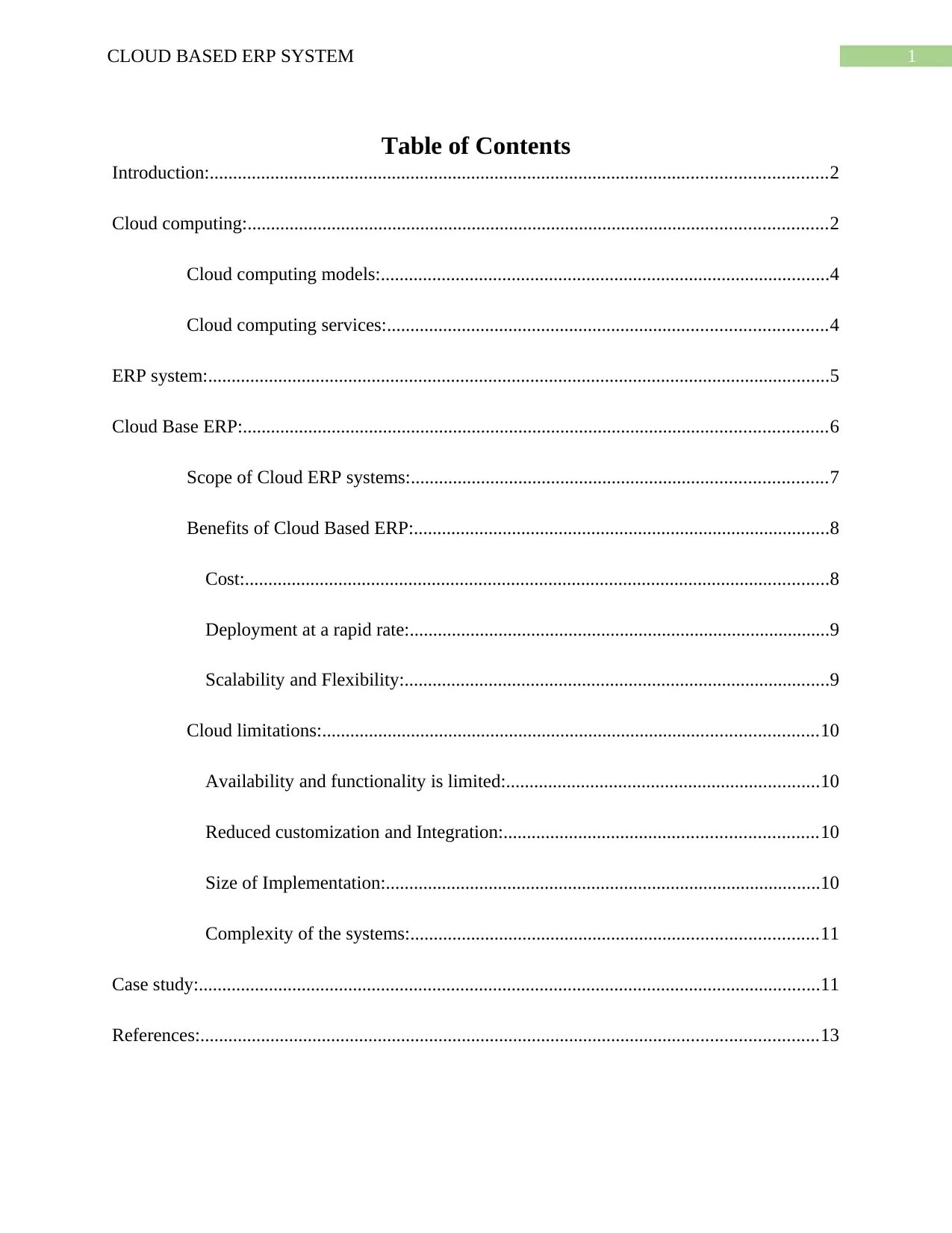
1CLOUD BASED ERP SYSTEM
Table of Contents
Introduction:....................................................................................................................................2
Cloud computing:............................................................................................................................2
Cloud computing models:................................................................................................4
Cloud computing services:..............................................................................................4
ERP system:.....................................................................................................................................5
Cloud Base ERP:.............................................................................................................................6
Scope of Cloud ERP systems:.........................................................................................7
Benefits of Cloud Based ERP:.........................................................................................8
Cost:.............................................................................................................................8
Deployment at a rapid rate:..........................................................................................9
Scalability and Flexibility:...........................................................................................9
Cloud limitations:..........................................................................................................10
Availability and functionality is limited:...................................................................10
Reduced customization and Integration:...................................................................10
Size of Implementation:.............................................................................................10
Complexity of the systems:.......................................................................................11
Case study:.....................................................................................................................................11
References:....................................................................................................................................13
Table of Contents
Introduction:....................................................................................................................................2
Cloud computing:............................................................................................................................2
Cloud computing models:................................................................................................4
Cloud computing services:..............................................................................................4
ERP system:.....................................................................................................................................5
Cloud Base ERP:.............................................................................................................................6
Scope of Cloud ERP systems:.........................................................................................7
Benefits of Cloud Based ERP:.........................................................................................8
Cost:.............................................................................................................................8
Deployment at a rapid rate:..........................................................................................9
Scalability and Flexibility:...........................................................................................9
Cloud limitations:..........................................................................................................10
Availability and functionality is limited:...................................................................10
Reduced customization and Integration:...................................................................10
Size of Implementation:.............................................................................................10
Complexity of the systems:.......................................................................................11
Case study:.....................................................................................................................................11
References:....................................................................................................................................13
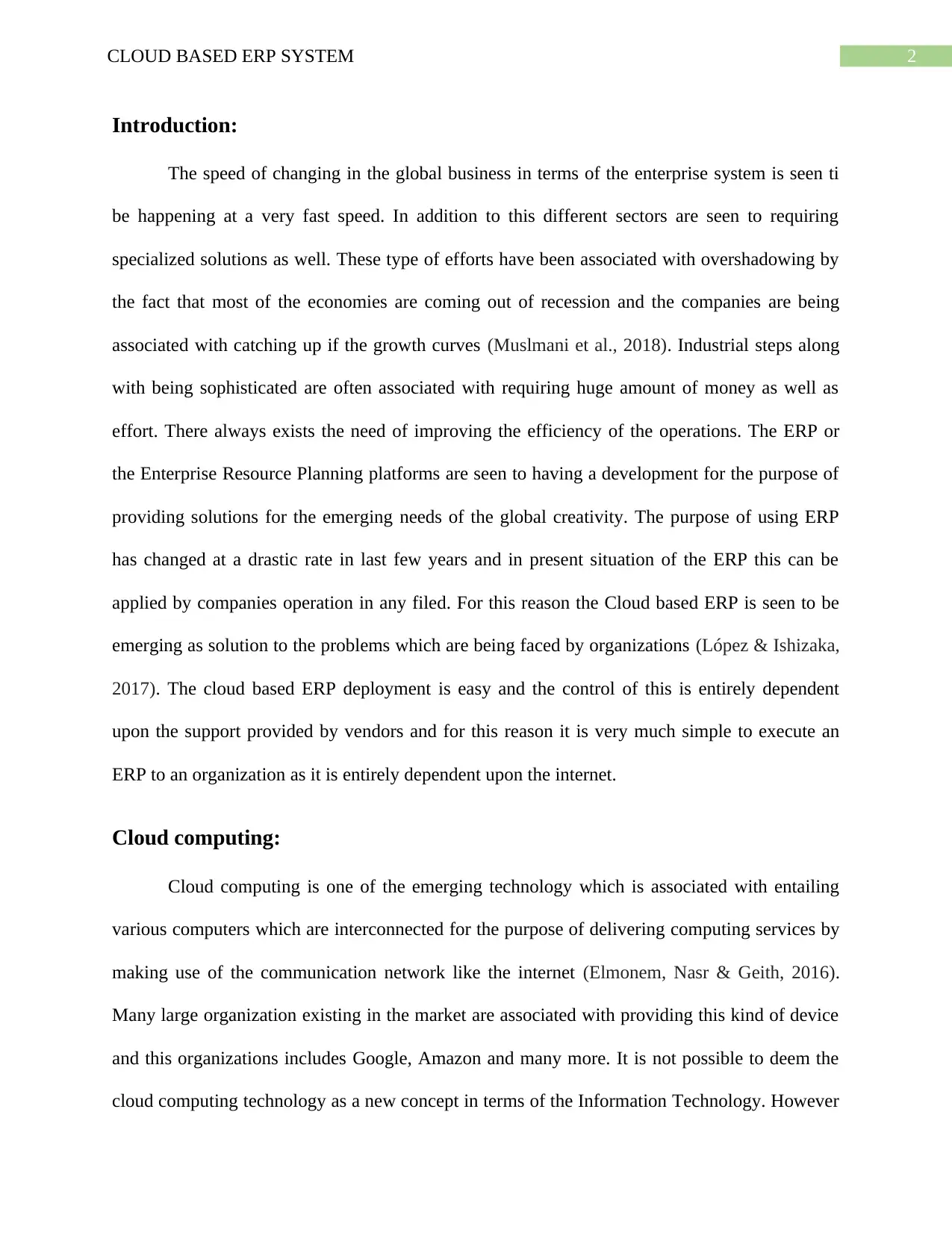
2CLOUD BASED ERP SYSTEM
Introduction:
The speed of changing in the global business in terms of the enterprise system is seen ti
be happening at a very fast speed. In addition to this different sectors are seen to requiring
specialized solutions as well. These type of efforts have been associated with overshadowing by
the fact that most of the economies are coming out of recession and the companies are being
associated with catching up if the growth curves (Muslmani et al., 2018). Industrial steps along
with being sophisticated are often associated with requiring huge amount of money as well as
effort. There always exists the need of improving the efficiency of the operations. The ERP or
the Enterprise Resource Planning platforms are seen to having a development for the purpose of
providing solutions for the emerging needs of the global creativity. The purpose of using ERP
has changed at a drastic rate in last few years and in present situation of the ERP this can be
applied by companies operation in any filed. For this reason the Cloud based ERP is seen to be
emerging as solution to the problems which are being faced by organizations (López & Ishizaka,
2017). The cloud based ERP deployment is easy and the control of this is entirely dependent
upon the support provided by vendors and for this reason it is very much simple to execute an
ERP to an organization as it is entirely dependent upon the internet.
Cloud computing:
Cloud computing is one of the emerging technology which is associated with entailing
various computers which are interconnected for the purpose of delivering computing services by
making use of the communication network like the internet (Elmonem, Nasr & Geith, 2016).
Many large organization existing in the market are associated with providing this kind of device
and this organizations includes Google, Amazon and many more. It is not possible to deem the
cloud computing technology as a new concept in terms of the Information Technology. However
Introduction:
The speed of changing in the global business in terms of the enterprise system is seen ti
be happening at a very fast speed. In addition to this different sectors are seen to requiring
specialized solutions as well. These type of efforts have been associated with overshadowing by
the fact that most of the economies are coming out of recession and the companies are being
associated with catching up if the growth curves (Muslmani et al., 2018). Industrial steps along
with being sophisticated are often associated with requiring huge amount of money as well as
effort. There always exists the need of improving the efficiency of the operations. The ERP or
the Enterprise Resource Planning platforms are seen to having a development for the purpose of
providing solutions for the emerging needs of the global creativity. The purpose of using ERP
has changed at a drastic rate in last few years and in present situation of the ERP this can be
applied by companies operation in any filed. For this reason the Cloud based ERP is seen to be
emerging as solution to the problems which are being faced by organizations (López & Ishizaka,
2017). The cloud based ERP deployment is easy and the control of this is entirely dependent
upon the support provided by vendors and for this reason it is very much simple to execute an
ERP to an organization as it is entirely dependent upon the internet.
Cloud computing:
Cloud computing is one of the emerging technology which is associated with entailing
various computers which are interconnected for the purpose of delivering computing services by
making use of the communication network like the internet (Elmonem, Nasr & Geith, 2016).
Many large organization existing in the market are associated with providing this kind of device
and this organizations includes Google, Amazon and many more. It is not possible to deem the
cloud computing technology as a new concept in terms of the Information Technology. However
⊘ This is a preview!⊘
Do you want full access?
Subscribe today to unlock all pages.

Trusted by 1+ million students worldwide
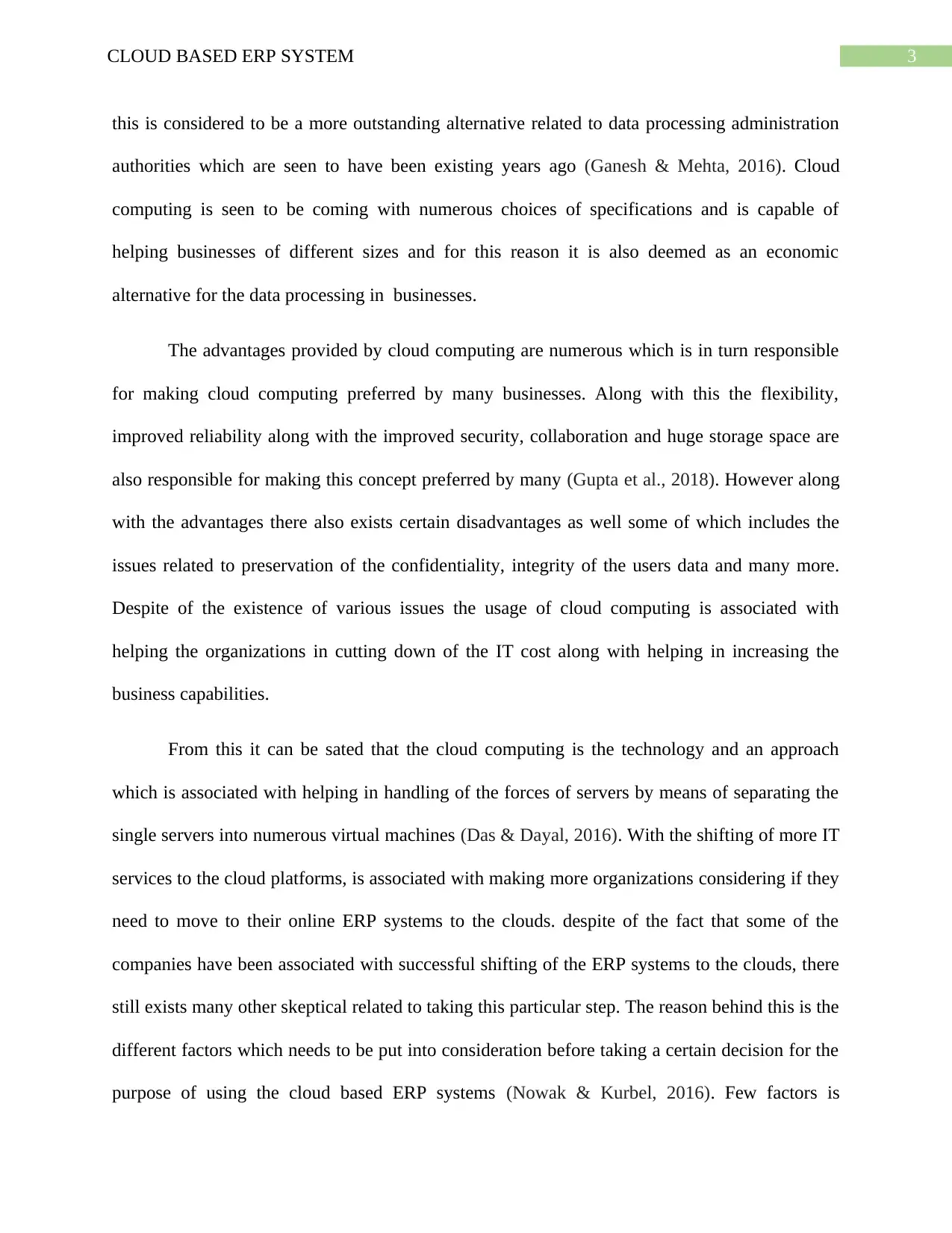
3CLOUD BASED ERP SYSTEM
this is considered to be a more outstanding alternative related to data processing administration
authorities which are seen to have been existing years ago (Ganesh & Mehta, 2016). Cloud
computing is seen to be coming with numerous choices of specifications and is capable of
helping businesses of different sizes and for this reason it is also deemed as an economic
alternative for the data processing in businesses.
The advantages provided by cloud computing are numerous which is in turn responsible
for making cloud computing preferred by many businesses. Along with this the flexibility,
improved reliability along with the improved security, collaboration and huge storage space are
also responsible for making this concept preferred by many (Gupta et al., 2018). However along
with the advantages there also exists certain disadvantages as well some of which includes the
issues related to preservation of the confidentiality, integrity of the users data and many more.
Despite of the existence of various issues the usage of cloud computing is associated with
helping the organizations in cutting down of the IT cost along with helping in increasing the
business capabilities.
From this it can be sated that the cloud computing is the technology and an approach
which is associated with helping in handling of the forces of servers by means of separating the
single servers into numerous virtual machines (Das & Dayal, 2016). With the shifting of more IT
services to the cloud platforms, is associated with making more organizations considering if they
need to move to their online ERP systems to the clouds. despite of the fact that some of the
companies have been associated with successful shifting of the ERP systems to the clouds, there
still exists many other skeptical related to taking this particular step. The reason behind this is the
different factors which needs to be put into consideration before taking a certain decision for the
purpose of using the cloud based ERP systems (Nowak & Kurbel, 2016). Few factors is
this is considered to be a more outstanding alternative related to data processing administration
authorities which are seen to have been existing years ago (Ganesh & Mehta, 2016). Cloud
computing is seen to be coming with numerous choices of specifications and is capable of
helping businesses of different sizes and for this reason it is also deemed as an economic
alternative for the data processing in businesses.
The advantages provided by cloud computing are numerous which is in turn responsible
for making cloud computing preferred by many businesses. Along with this the flexibility,
improved reliability along with the improved security, collaboration and huge storage space are
also responsible for making this concept preferred by many (Gupta et al., 2018). However along
with the advantages there also exists certain disadvantages as well some of which includes the
issues related to preservation of the confidentiality, integrity of the users data and many more.
Despite of the existence of various issues the usage of cloud computing is associated with
helping the organizations in cutting down of the IT cost along with helping in increasing the
business capabilities.
From this it can be sated that the cloud computing is the technology and an approach
which is associated with helping in handling of the forces of servers by means of separating the
single servers into numerous virtual machines (Das & Dayal, 2016). With the shifting of more IT
services to the cloud platforms, is associated with making more organizations considering if they
need to move to their online ERP systems to the clouds. despite of the fact that some of the
companies have been associated with successful shifting of the ERP systems to the clouds, there
still exists many other skeptical related to taking this particular step. The reason behind this is the
different factors which needs to be put into consideration before taking a certain decision for the
purpose of using the cloud based ERP systems (Nowak & Kurbel, 2016). Few factors is
Paraphrase This Document
Need a fresh take? Get an instant paraphrase of this document with our AI Paraphraser
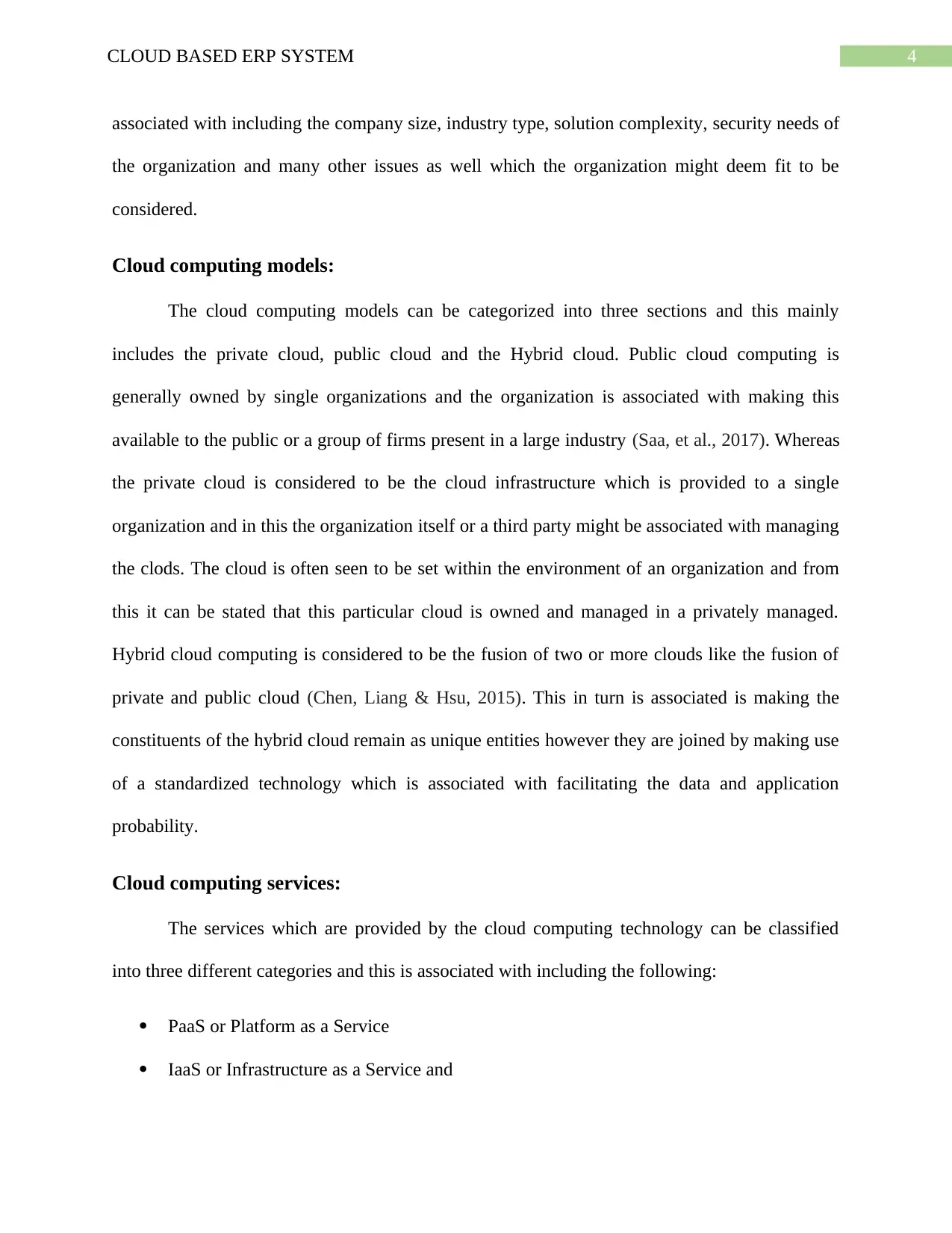
4CLOUD BASED ERP SYSTEM
associated with including the company size, industry type, solution complexity, security needs of
the organization and many other issues as well which the organization might deem fit to be
considered.
Cloud computing models:
The cloud computing models can be categorized into three sections and this mainly
includes the private cloud, public cloud and the Hybrid cloud. Public cloud computing is
generally owned by single organizations and the organization is associated with making this
available to the public or a group of firms present in a large industry (Saa, et al., 2017). Whereas
the private cloud is considered to be the cloud infrastructure which is provided to a single
organization and in this the organization itself or a third party might be associated with managing
the clods. The cloud is often seen to be set within the environment of an organization and from
this it can be stated that this particular cloud is owned and managed in a privately managed.
Hybrid cloud computing is considered to be the fusion of two or more clouds like the fusion of
private and public cloud (Chen, Liang & Hsu, 2015). This in turn is associated is making the
constituents of the hybrid cloud remain as unique entities however they are joined by making use
of a standardized technology which is associated with facilitating the data and application
probability.
Cloud computing services:
The services which are provided by the cloud computing technology can be classified
into three different categories and this is associated with including the following:
PaaS or Platform as a Service
IaaS or Infrastructure as a Service and
associated with including the company size, industry type, solution complexity, security needs of
the organization and many other issues as well which the organization might deem fit to be
considered.
Cloud computing models:
The cloud computing models can be categorized into three sections and this mainly
includes the private cloud, public cloud and the Hybrid cloud. Public cloud computing is
generally owned by single organizations and the organization is associated with making this
available to the public or a group of firms present in a large industry (Saa, et al., 2017). Whereas
the private cloud is considered to be the cloud infrastructure which is provided to a single
organization and in this the organization itself or a third party might be associated with managing
the clods. The cloud is often seen to be set within the environment of an organization and from
this it can be stated that this particular cloud is owned and managed in a privately managed.
Hybrid cloud computing is considered to be the fusion of two or more clouds like the fusion of
private and public cloud (Chen, Liang & Hsu, 2015). This in turn is associated is making the
constituents of the hybrid cloud remain as unique entities however they are joined by making use
of a standardized technology which is associated with facilitating the data and application
probability.
Cloud computing services:
The services which are provided by the cloud computing technology can be classified
into three different categories and this is associated with including the following:
PaaS or Platform as a Service
IaaS or Infrastructure as a Service and
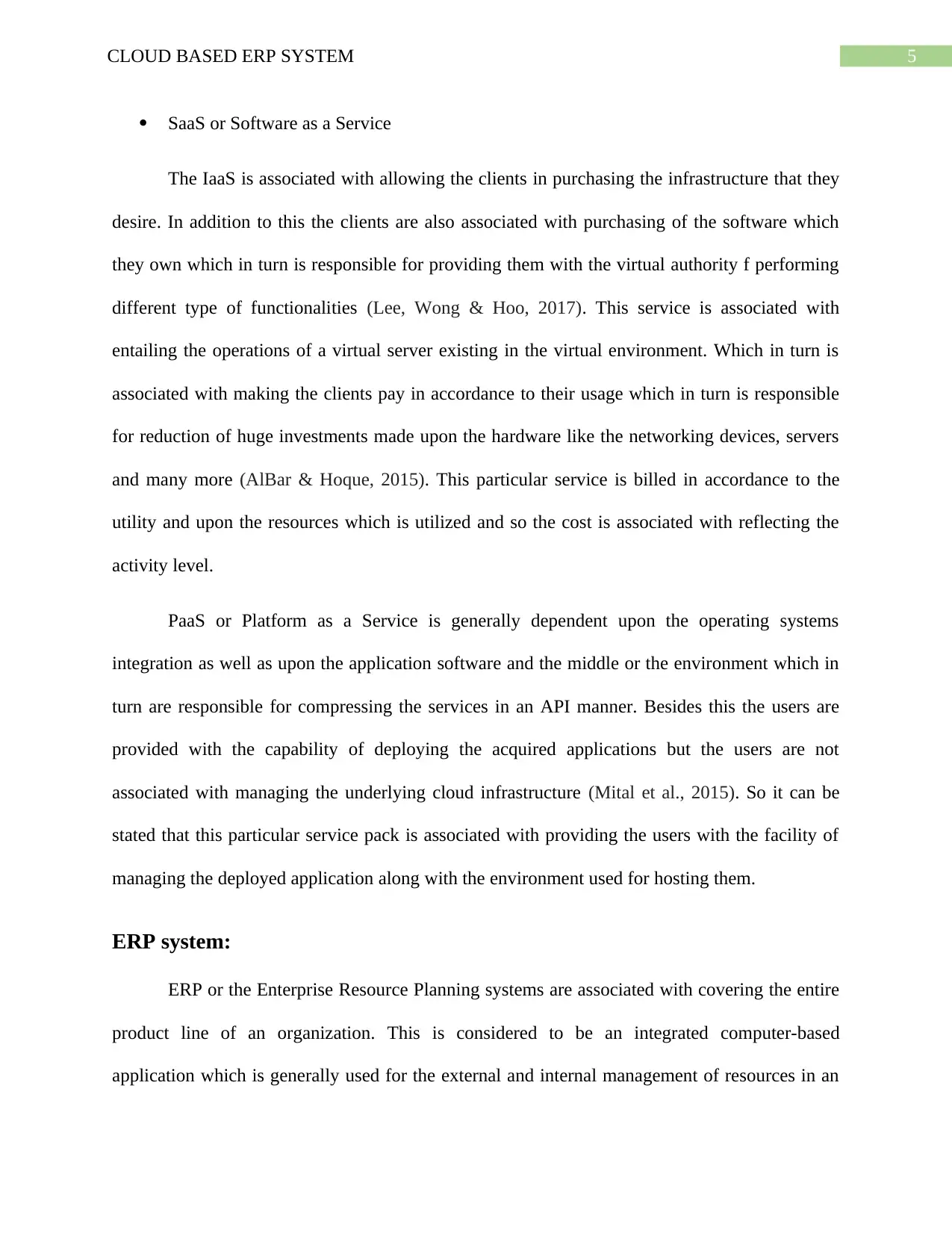
5CLOUD BASED ERP SYSTEM
SaaS or Software as a Service
The IaaS is associated with allowing the clients in purchasing the infrastructure that they
desire. In addition to this the clients are also associated with purchasing of the software which
they own which in turn is responsible for providing them with the virtual authority f performing
different type of functionalities (Lee, Wong & Hoo, 2017). This service is associated with
entailing the operations of a virtual server existing in the virtual environment. Which in turn is
associated with making the clients pay in accordance to their usage which in turn is responsible
for reduction of huge investments made upon the hardware like the networking devices, servers
and many more (AlBar & Hoque, 2015). This particular service is billed in accordance to the
utility and upon the resources which is utilized and so the cost is associated with reflecting the
activity level.
PaaS or Platform as a Service is generally dependent upon the operating systems
integration as well as upon the application software and the middle or the environment which in
turn are responsible for compressing the services in an API manner. Besides this the users are
provided with the capability of deploying the acquired applications but the users are not
associated with managing the underlying cloud infrastructure (Mital et al., 2015). So it can be
stated that this particular service pack is associated with providing the users with the facility of
managing the deployed application along with the environment used for hosting them.
ERP system:
ERP or the Enterprise Resource Planning systems are associated with covering the entire
product line of an organization. This is considered to be an integrated computer-based
application which is generally used for the external and internal management of resources in an
SaaS or Software as a Service
The IaaS is associated with allowing the clients in purchasing the infrastructure that they
desire. In addition to this the clients are also associated with purchasing of the software which
they own which in turn is responsible for providing them with the virtual authority f performing
different type of functionalities (Lee, Wong & Hoo, 2017). This service is associated with
entailing the operations of a virtual server existing in the virtual environment. Which in turn is
associated with making the clients pay in accordance to their usage which in turn is responsible
for reduction of huge investments made upon the hardware like the networking devices, servers
and many more (AlBar & Hoque, 2015). This particular service is billed in accordance to the
utility and upon the resources which is utilized and so the cost is associated with reflecting the
activity level.
PaaS or Platform as a Service is generally dependent upon the operating systems
integration as well as upon the application software and the middle or the environment which in
turn are responsible for compressing the services in an API manner. Besides this the users are
provided with the capability of deploying the acquired applications but the users are not
associated with managing the underlying cloud infrastructure (Mital et al., 2015). So it can be
stated that this particular service pack is associated with providing the users with the facility of
managing the deployed application along with the environment used for hosting them.
ERP system:
ERP or the Enterprise Resource Planning systems are associated with covering the entire
product line of an organization. This is considered to be an integrated computer-based
application which is generally used for the external and internal management of resources in an
⊘ This is a preview!⊘
Do you want full access?
Subscribe today to unlock all pages.

Trusted by 1+ million students worldwide
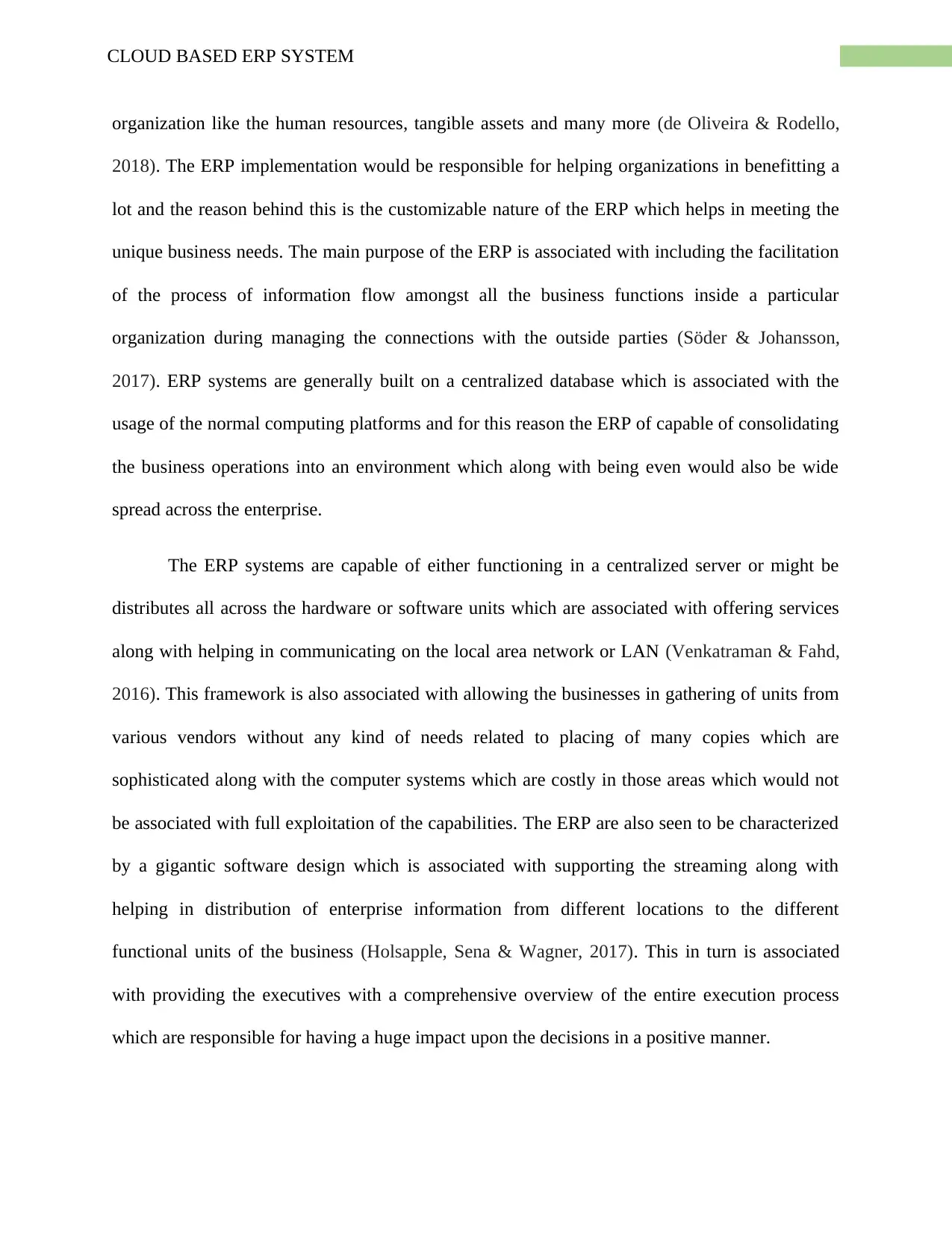
6CLOUD BASED ERP SYSTEM
organization like the human resources, tangible assets and many more (de Oliveira & Rodello,
2018). The ERP implementation would be responsible for helping organizations in benefitting a
lot and the reason behind this is the customizable nature of the ERP which helps in meeting the
unique business needs. The main purpose of the ERP is associated with including the facilitation
of the process of information flow amongst all the business functions inside a particular
organization during managing the connections with the outside parties (Söder & Johansson,
2017). ERP systems are generally built on a centralized database which is associated with the
usage of the normal computing platforms and for this reason the ERP of capable of consolidating
the business operations into an environment which along with being even would also be wide
spread across the enterprise.
The ERP systems are capable of either functioning in a centralized server or might be
distributes all across the hardware or software units which are associated with offering services
along with helping in communicating on the local area network or LAN (Venkatraman & Fahd,
2016). This framework is also associated with allowing the businesses in gathering of units from
various vendors without any kind of needs related to placing of many copies which are
sophisticated along with the computer systems which are costly in those areas which would not
be associated with full exploitation of the capabilities. The ERP are also seen to be characterized
by a gigantic software design which is associated with supporting the streaming along with
helping in distribution of enterprise information from different locations to the different
functional units of the business (Holsapple, Sena & Wagner, 2017). This in turn is associated
with providing the executives with a comprehensive overview of the entire execution process
which are responsible for having a huge impact upon the decisions in a positive manner.
organization like the human resources, tangible assets and many more (de Oliveira & Rodello,
2018). The ERP implementation would be responsible for helping organizations in benefitting a
lot and the reason behind this is the customizable nature of the ERP which helps in meeting the
unique business needs. The main purpose of the ERP is associated with including the facilitation
of the process of information flow amongst all the business functions inside a particular
organization during managing the connections with the outside parties (Söder & Johansson,
2017). ERP systems are generally built on a centralized database which is associated with the
usage of the normal computing platforms and for this reason the ERP of capable of consolidating
the business operations into an environment which along with being even would also be wide
spread across the enterprise.
The ERP systems are capable of either functioning in a centralized server or might be
distributes all across the hardware or software units which are associated with offering services
along with helping in communicating on the local area network or LAN (Venkatraman & Fahd,
2016). This framework is also associated with allowing the businesses in gathering of units from
various vendors without any kind of needs related to placing of many copies which are
sophisticated along with the computer systems which are costly in those areas which would not
be associated with full exploitation of the capabilities. The ERP are also seen to be characterized
by a gigantic software design which is associated with supporting the streaming along with
helping in distribution of enterprise information from different locations to the different
functional units of the business (Holsapple, Sena & Wagner, 2017). This in turn is associated
with providing the executives with a comprehensive overview of the entire execution process
which are responsible for having a huge impact upon the decisions in a positive manner.
Paraphrase This Document
Need a fresh take? Get an instant paraphrase of this document with our AI Paraphraser
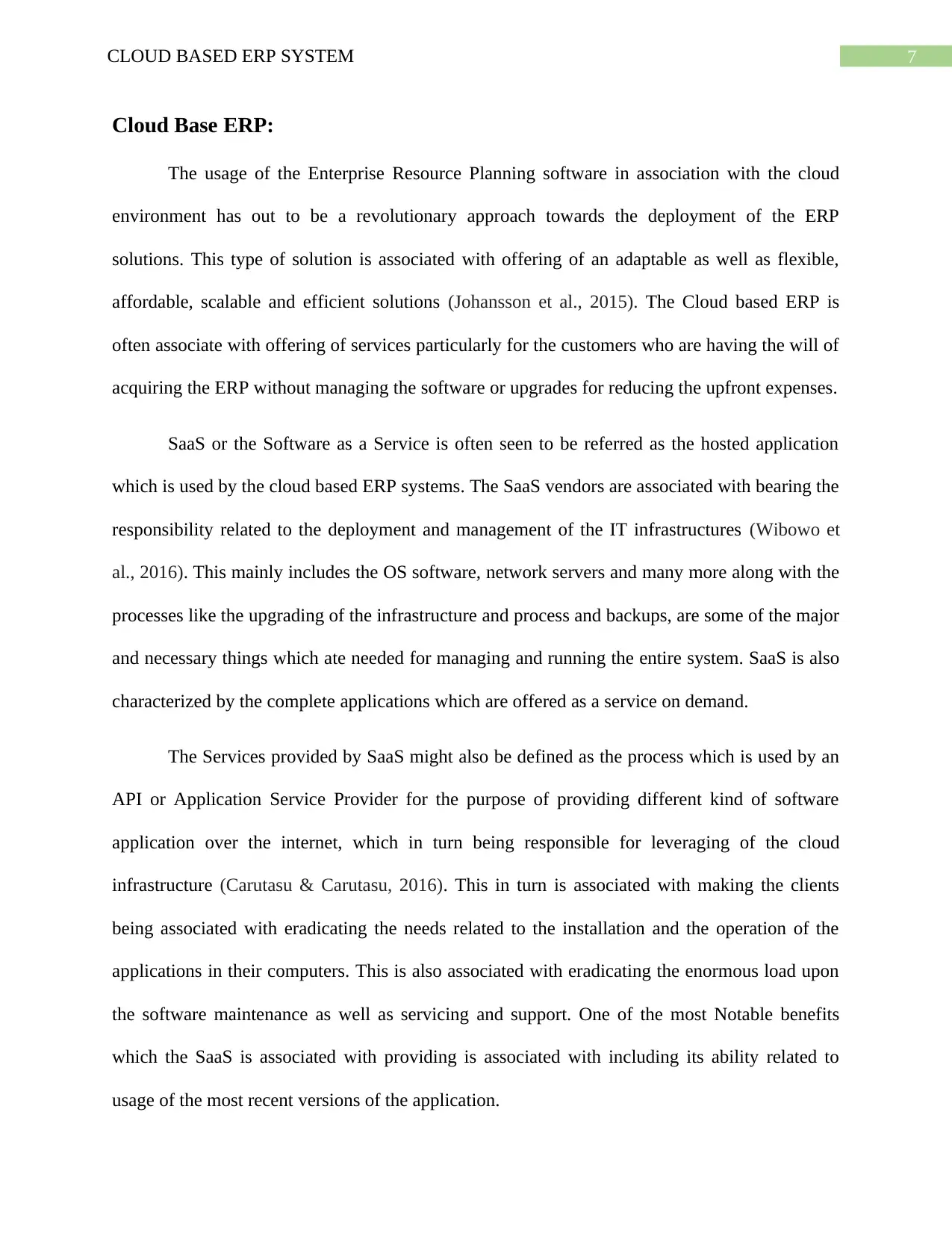
7CLOUD BASED ERP SYSTEM
Cloud Base ERP:
The usage of the Enterprise Resource Planning software in association with the cloud
environment has out to be a revolutionary approach towards the deployment of the ERP
solutions. This type of solution is associated with offering of an adaptable as well as flexible,
affordable, scalable and efficient solutions (Johansson et al., 2015). The Cloud based ERP is
often associate with offering of services particularly for the customers who are having the will of
acquiring the ERP without managing the software or upgrades for reducing the upfront expenses.
SaaS or the Software as a Service is often seen to be referred as the hosted application
which is used by the cloud based ERP systems. The SaaS vendors are associated with bearing the
responsibility related to the deployment and management of the IT infrastructures (Wibowo et
al., 2016). This mainly includes the OS software, network servers and many more along with the
processes like the upgrading of the infrastructure and process and backups, are some of the major
and necessary things which ate needed for managing and running the entire system. SaaS is also
characterized by the complete applications which are offered as a service on demand.
The Services provided by SaaS might also be defined as the process which is used by an
API or Application Service Provider for the purpose of providing different kind of software
application over the internet, which in turn being responsible for leveraging of the cloud
infrastructure (Carutasu & Carutasu, 2016). This in turn is associated with making the clients
being associated with eradicating the needs related to the installation and the operation of the
applications in their computers. This is also associated with eradicating the enormous load upon
the software maintenance as well as servicing and support. One of the most Notable benefits
which the SaaS is associated with providing is associated with including its ability related to
usage of the most recent versions of the application.
Cloud Base ERP:
The usage of the Enterprise Resource Planning software in association with the cloud
environment has out to be a revolutionary approach towards the deployment of the ERP
solutions. This type of solution is associated with offering of an adaptable as well as flexible,
affordable, scalable and efficient solutions (Johansson et al., 2015). The Cloud based ERP is
often associate with offering of services particularly for the customers who are having the will of
acquiring the ERP without managing the software or upgrades for reducing the upfront expenses.
SaaS or the Software as a Service is often seen to be referred as the hosted application
which is used by the cloud based ERP systems. The SaaS vendors are associated with bearing the
responsibility related to the deployment and management of the IT infrastructures (Wibowo et
al., 2016). This mainly includes the OS software, network servers and many more along with the
processes like the upgrading of the infrastructure and process and backups, are some of the major
and necessary things which ate needed for managing and running the entire system. SaaS is also
characterized by the complete applications which are offered as a service on demand.
The Services provided by SaaS might also be defined as the process which is used by an
API or Application Service Provider for the purpose of providing different kind of software
application over the internet, which in turn being responsible for leveraging of the cloud
infrastructure (Carutasu & Carutasu, 2016). This in turn is associated with making the clients
being associated with eradicating the needs related to the installation and the operation of the
applications in their computers. This is also associated with eradicating the enormous load upon
the software maintenance as well as servicing and support. One of the most Notable benefits
which the SaaS is associated with providing is associated with including its ability related to
usage of the most recent versions of the application.
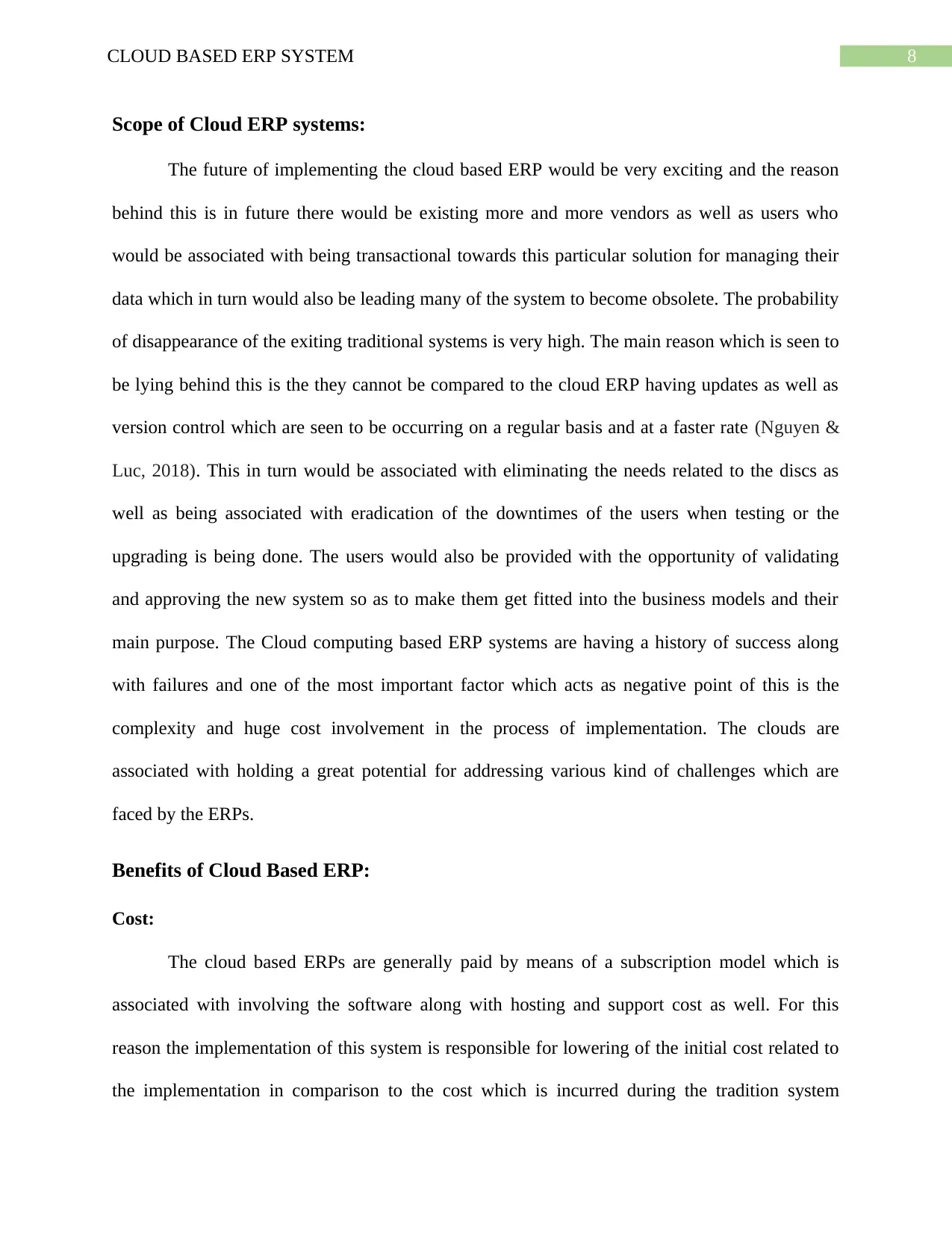
8CLOUD BASED ERP SYSTEM
Scope of Cloud ERP systems:
The future of implementing the cloud based ERP would be very exciting and the reason
behind this is in future there would be existing more and more vendors as well as users who
would be associated with being transactional towards this particular solution for managing their
data which in turn would also be leading many of the system to become obsolete. The probability
of disappearance of the exiting traditional systems is very high. The main reason which is seen to
be lying behind this is the they cannot be compared to the cloud ERP having updates as well as
version control which are seen to be occurring on a regular basis and at a faster rate (Nguyen &
Luc, 2018). This in turn would be associated with eliminating the needs related to the discs as
well as being associated with eradication of the downtimes of the users when testing or the
upgrading is being done. The users would also be provided with the opportunity of validating
and approving the new system so as to make them get fitted into the business models and their
main purpose. The Cloud computing based ERP systems are having a history of success along
with failures and one of the most important factor which acts as negative point of this is the
complexity and huge cost involvement in the process of implementation. The clouds are
associated with holding a great potential for addressing various kind of challenges which are
faced by the ERPs.
Benefits of Cloud Based ERP:
Cost:
The cloud based ERPs are generally paid by means of a subscription model which is
associated with involving the software along with hosting and support cost as well. For this
reason the implementation of this system is responsible for lowering of the initial cost related to
the implementation in comparison to the cost which is incurred during the tradition system
Scope of Cloud ERP systems:
The future of implementing the cloud based ERP would be very exciting and the reason
behind this is in future there would be existing more and more vendors as well as users who
would be associated with being transactional towards this particular solution for managing their
data which in turn would also be leading many of the system to become obsolete. The probability
of disappearance of the exiting traditional systems is very high. The main reason which is seen to
be lying behind this is the they cannot be compared to the cloud ERP having updates as well as
version control which are seen to be occurring on a regular basis and at a faster rate (Nguyen &
Luc, 2018). This in turn would be associated with eliminating the needs related to the discs as
well as being associated with eradication of the downtimes of the users when testing or the
upgrading is being done. The users would also be provided with the opportunity of validating
and approving the new system so as to make them get fitted into the business models and their
main purpose. The Cloud computing based ERP systems are having a history of success along
with failures and one of the most important factor which acts as negative point of this is the
complexity and huge cost involvement in the process of implementation. The clouds are
associated with holding a great potential for addressing various kind of challenges which are
faced by the ERPs.
Benefits of Cloud Based ERP:
Cost:
The cloud based ERPs are generally paid by means of a subscription model which is
associated with involving the software along with hosting and support cost as well. For this
reason the implementation of this system is responsible for lowering of the initial cost related to
the implementation in comparison to the cost which is incurred during the tradition system
⊘ This is a preview!⊘
Do you want full access?
Subscribe today to unlock all pages.

Trusted by 1+ million students worldwide
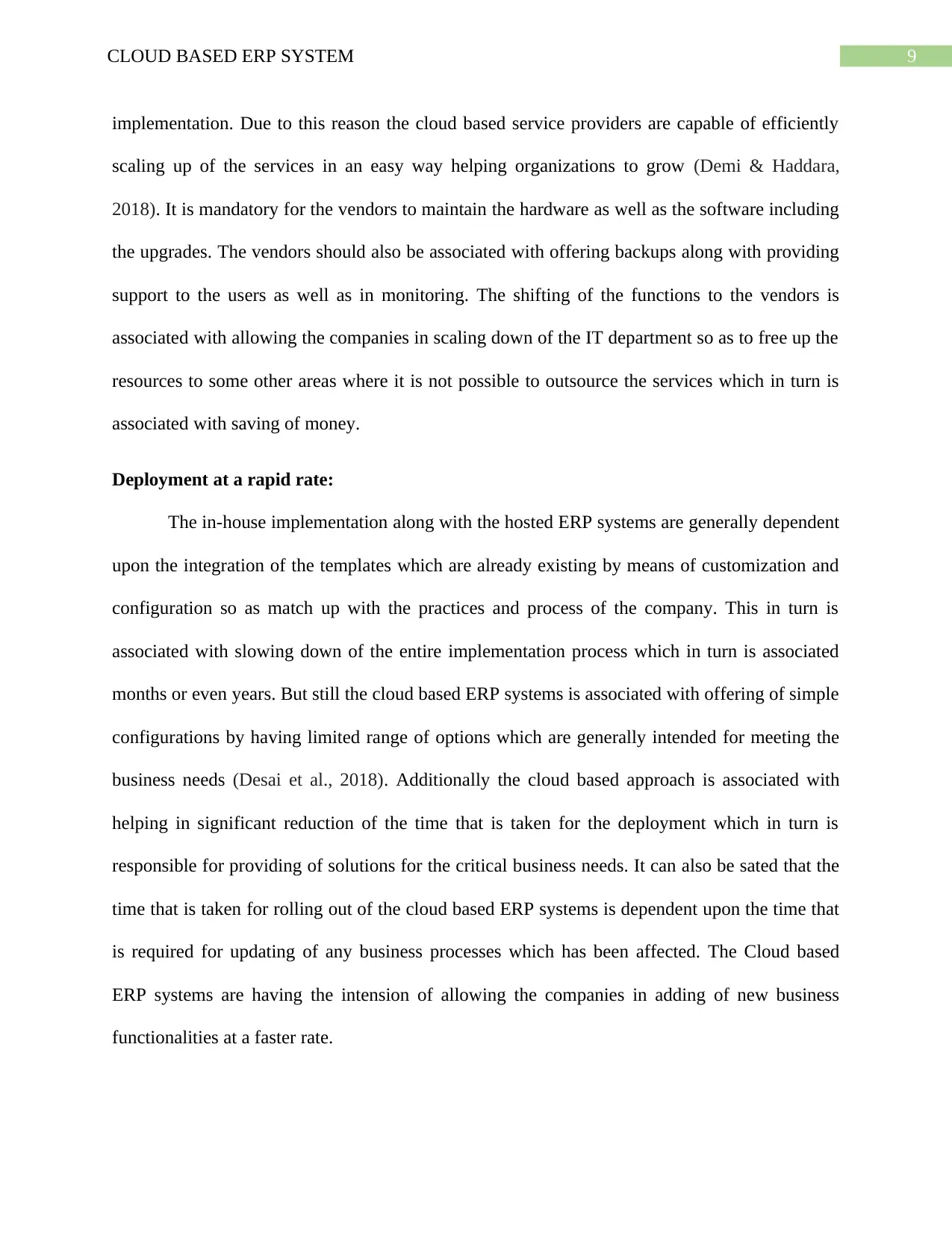
9CLOUD BASED ERP SYSTEM
implementation. Due to this reason the cloud based service providers are capable of efficiently
scaling up of the services in an easy way helping organizations to grow (Demi & Haddara,
2018). It is mandatory for the vendors to maintain the hardware as well as the software including
the upgrades. The vendors should also be associated with offering backups along with providing
support to the users as well as in monitoring. The shifting of the functions to the vendors is
associated with allowing the companies in scaling down of the IT department so as to free up the
resources to some other areas where it is not possible to outsource the services which in turn is
associated with saving of money.
Deployment at a rapid rate:
The in-house implementation along with the hosted ERP systems are generally dependent
upon the integration of the templates which are already existing by means of customization and
configuration so as match up with the practices and process of the company. This in turn is
associated with slowing down of the entire implementation process which in turn is associated
months or even years. But still the cloud based ERP systems is associated with offering of simple
configurations by having limited range of options which are generally intended for meeting the
business needs (Desai et al., 2018). Additionally the cloud based approach is associated with
helping in significant reduction of the time that is taken for the deployment which in turn is
responsible for providing of solutions for the critical business needs. It can also be sated that the
time that is taken for rolling out of the cloud based ERP systems is dependent upon the time that
is required for updating of any business processes which has been affected. The Cloud based
ERP systems are having the intension of allowing the companies in adding of new business
functionalities at a faster rate.
implementation. Due to this reason the cloud based service providers are capable of efficiently
scaling up of the services in an easy way helping organizations to grow (Demi & Haddara,
2018). It is mandatory for the vendors to maintain the hardware as well as the software including
the upgrades. The vendors should also be associated with offering backups along with providing
support to the users as well as in monitoring. The shifting of the functions to the vendors is
associated with allowing the companies in scaling down of the IT department so as to free up the
resources to some other areas where it is not possible to outsource the services which in turn is
associated with saving of money.
Deployment at a rapid rate:
The in-house implementation along with the hosted ERP systems are generally dependent
upon the integration of the templates which are already existing by means of customization and
configuration so as match up with the practices and process of the company. This in turn is
associated with slowing down of the entire implementation process which in turn is associated
months or even years. But still the cloud based ERP systems is associated with offering of simple
configurations by having limited range of options which are generally intended for meeting the
business needs (Desai et al., 2018). Additionally the cloud based approach is associated with
helping in significant reduction of the time that is taken for the deployment which in turn is
responsible for providing of solutions for the critical business needs. It can also be sated that the
time that is taken for rolling out of the cloud based ERP systems is dependent upon the time that
is required for updating of any business processes which has been affected. The Cloud based
ERP systems are having the intension of allowing the companies in adding of new business
functionalities at a faster rate.
Paraphrase This Document
Need a fresh take? Get an instant paraphrase of this document with our AI Paraphraser
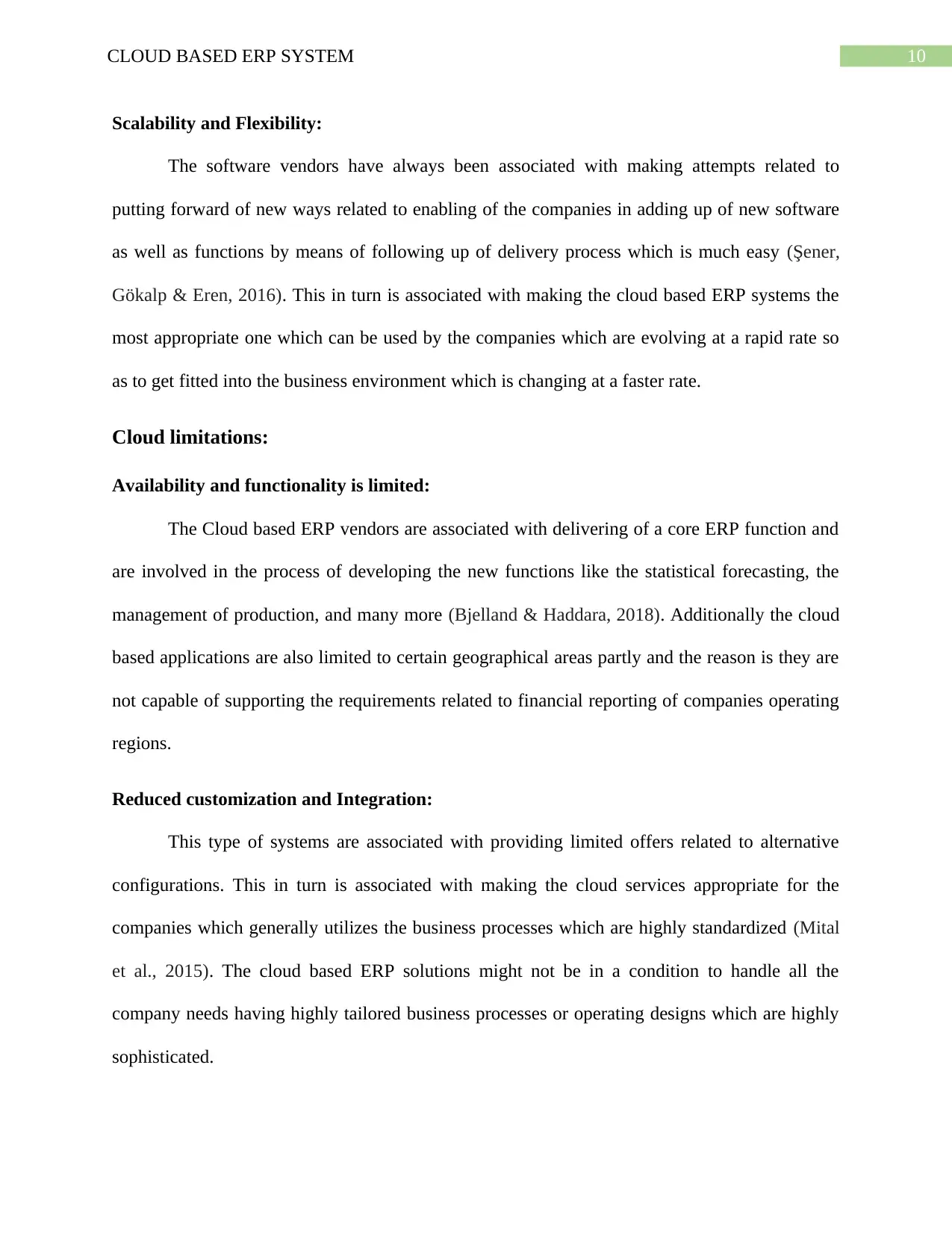
10CLOUD BASED ERP SYSTEM
Scalability and Flexibility:
The software vendors have always been associated with making attempts related to
putting forward of new ways related to enabling of the companies in adding up of new software
as well as functions by means of following up of delivery process which is much easy (Şener,
Gökalp & Eren, 2016). This in turn is associated with making the cloud based ERP systems the
most appropriate one which can be used by the companies which are evolving at a rapid rate so
as to get fitted into the business environment which is changing at a faster rate.
Cloud limitations:
Availability and functionality is limited:
The Cloud based ERP vendors are associated with delivering of a core ERP function and
are involved in the process of developing the new functions like the statistical forecasting, the
management of production, and many more (Bjelland & Haddara, 2018). Additionally the cloud
based applications are also limited to certain geographical areas partly and the reason is they are
not capable of supporting the requirements related to financial reporting of companies operating
regions.
Reduced customization and Integration:
This type of systems are associated with providing limited offers related to alternative
configurations. This in turn is associated with making the cloud services appropriate for the
companies which generally utilizes the business processes which are highly standardized (Mital
et al., 2015). The cloud based ERP solutions might not be in a condition to handle all the
company needs having highly tailored business processes or operating designs which are highly
sophisticated.
Scalability and Flexibility:
The software vendors have always been associated with making attempts related to
putting forward of new ways related to enabling of the companies in adding up of new software
as well as functions by means of following up of delivery process which is much easy (Şener,
Gökalp & Eren, 2016). This in turn is associated with making the cloud based ERP systems the
most appropriate one which can be used by the companies which are evolving at a rapid rate so
as to get fitted into the business environment which is changing at a faster rate.
Cloud limitations:
Availability and functionality is limited:
The Cloud based ERP vendors are associated with delivering of a core ERP function and
are involved in the process of developing the new functions like the statistical forecasting, the
management of production, and many more (Bjelland & Haddara, 2018). Additionally the cloud
based applications are also limited to certain geographical areas partly and the reason is they are
not capable of supporting the requirements related to financial reporting of companies operating
regions.
Reduced customization and Integration:
This type of systems are associated with providing limited offers related to alternative
configurations. This in turn is associated with making the cloud services appropriate for the
companies which generally utilizes the business processes which are highly standardized (Mital
et al., 2015). The cloud based ERP solutions might not be in a condition to handle all the
company needs having highly tailored business processes or operating designs which are highly
sophisticated.
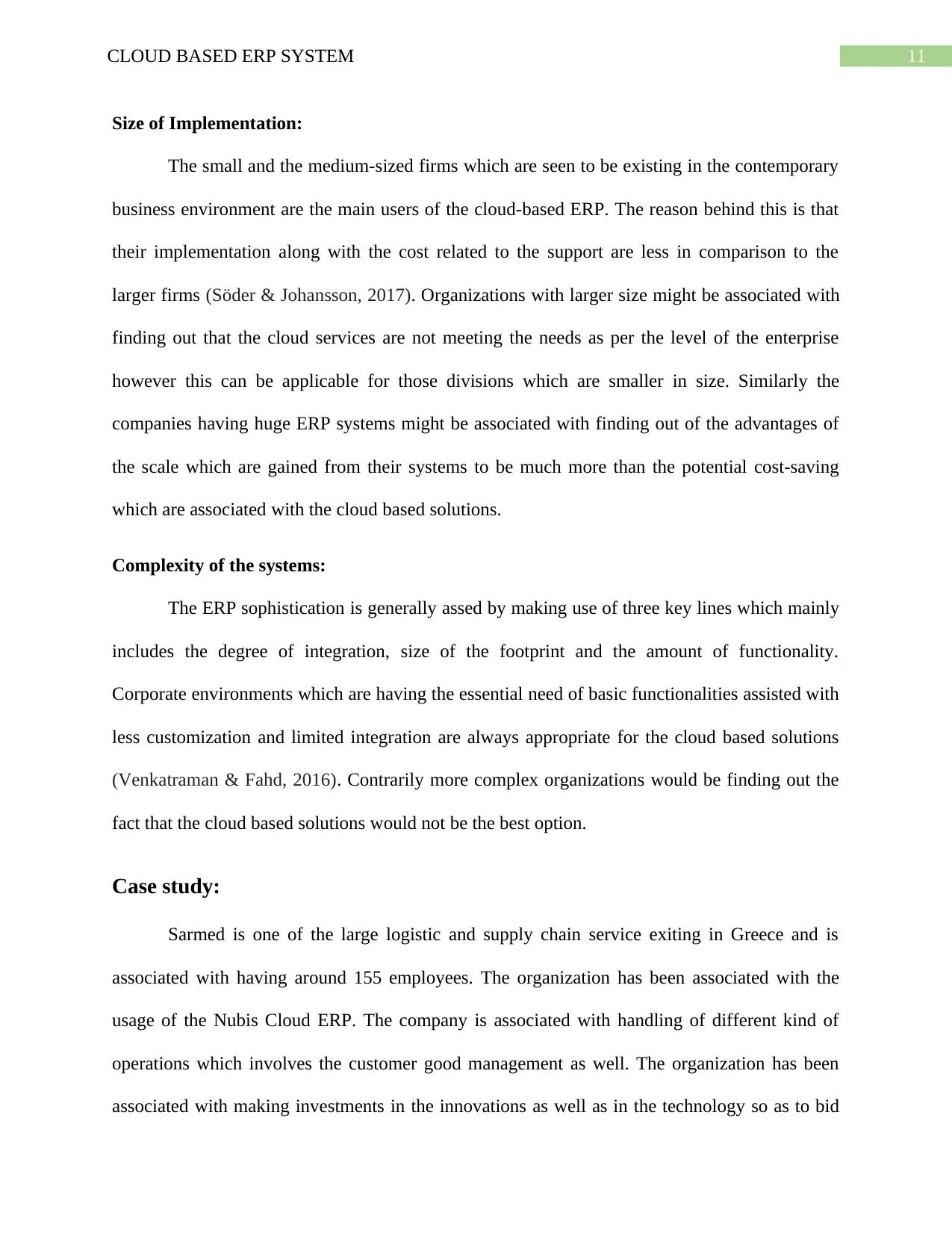
11CLOUD BASED ERP SYSTEM
Size of Implementation:
The small and the medium-sized firms which are seen to be existing in the contemporary
business environment are the main users of the cloud-based ERP. The reason behind this is that
their implementation along with the cost related to the support are less in comparison to the
larger firms (Söder & Johansson, 2017). Organizations with larger size might be associated with
finding out that the cloud services are not meeting the needs as per the level of the enterprise
however this can be applicable for those divisions which are smaller in size. Similarly the
companies having huge ERP systems might be associated with finding out of the advantages of
the scale which are gained from their systems to be much more than the potential cost-saving
which are associated with the cloud based solutions.
Complexity of the systems:
The ERP sophistication is generally assed by making use of three key lines which mainly
includes the degree of integration, size of the footprint and the amount of functionality.
Corporate environments which are having the essential need of basic functionalities assisted with
less customization and limited integration are always appropriate for the cloud based solutions
(Venkatraman & Fahd, 2016). Contrarily more complex organizations would be finding out the
fact that the cloud based solutions would not be the best option.
Case study:
Sarmed is one of the large logistic and supply chain service exiting in Greece and is
associated with having around 155 employees. The organization has been associated with the
usage of the Nubis Cloud ERP. The company is associated with handling of different kind of
operations which involves the customer good management as well. The organization has been
associated with making investments in the innovations as well as in the technology so as to bid
Size of Implementation:
The small and the medium-sized firms which are seen to be existing in the contemporary
business environment are the main users of the cloud-based ERP. The reason behind this is that
their implementation along with the cost related to the support are less in comparison to the
larger firms (Söder & Johansson, 2017). Organizations with larger size might be associated with
finding out that the cloud services are not meeting the needs as per the level of the enterprise
however this can be applicable for those divisions which are smaller in size. Similarly the
companies having huge ERP systems might be associated with finding out of the advantages of
the scale which are gained from their systems to be much more than the potential cost-saving
which are associated with the cloud based solutions.
Complexity of the systems:
The ERP sophistication is generally assed by making use of three key lines which mainly
includes the degree of integration, size of the footprint and the amount of functionality.
Corporate environments which are having the essential need of basic functionalities assisted with
less customization and limited integration are always appropriate for the cloud based solutions
(Venkatraman & Fahd, 2016). Contrarily more complex organizations would be finding out the
fact that the cloud based solutions would not be the best option.
Case study:
Sarmed is one of the large logistic and supply chain service exiting in Greece and is
associated with having around 155 employees. The organization has been associated with the
usage of the Nubis Cloud ERP. The company is associated with handling of different kind of
operations which involves the customer good management as well. The organization has been
associated with making investments in the innovations as well as in the technology so as to bid
⊘ This is a preview!⊘
Do you want full access?
Subscribe today to unlock all pages.

Trusted by 1+ million students worldwide
1 out of 17
Related Documents
Your All-in-One AI-Powered Toolkit for Academic Success.
+13062052269
info@desklib.com
Available 24*7 on WhatsApp / Email
![[object Object]](/_next/static/media/star-bottom.7253800d.svg)
Unlock your academic potential
Copyright © 2020–2025 A2Z Services. All Rights Reserved. Developed and managed by ZUCOL.





